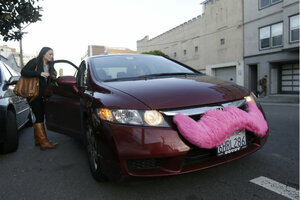GM invests $500 million in Lyft. Are we closer to self-driving cars?
The partnership gives General Motors an edge over competitors working to establish their own ridesharing services and gives both Lyft and GM a powerful ally in the autonomous-driving scrum playing out between Uber, Google, Tesla, and Apple, among others.

In this Jan. 4, 2013, file photo, Lyft passenger Christina Shatzen gets into a car driven by Nancy Tcheou, in San Francisco.
Jeff Chiu/AP/File
A 107 year-old American automaker is teaming up with a three-year-old ride-hailing startup out of San Francisco to develop a fleet of self-driving cars. Welcome to 2016.
General Motors Co. announced a $500 million investment in Lyft Inc. on Monday, and an “alliance” that will bring the pair right into the autonomous-driving scrum playing out between Uber, Google, Tesla, and Apple, among others.
Lyft Co-Founder and President John Zimmer and GM President Dan Ammann said in interviews with the Associated Press that the two companies started serious talks about three months ago. Both foresee major change in the traditional model of car ownership, and they shared similar ideas about how to address it.
"It felt very natural very quickly," Mr. Zimmer said to the AP.
Mr. Ammann said the partnership that came out of the talks, and the investment that made up half of Lyft's latest $1 billion Series-F round of funding, is unlike anything else happening in either the auto or tech industries.
"Do we want to deploy the resources and people to do everything ourselves, or get there faster by working in partnership?" Ammann said. "We see a really compelling, complimentary set of capabilities."
Effective "immediately" according to GM, the partnership will establish rental stations around the country from which Lyft drivers can rent GM vehicles on a short-term basis. The plan could put more Lyft drivers on the road as would-be drivers who don't own cars are provided an option to rent, and then drive and earn money through Lyft. The plan gives GM an edge over competitors like Daimler AG and Ford Motor Co., who are developing their own ride-sharing services, AP reports.
In the future, the two companies plan to build a self-driving car fleet that could be hailed using Lyft's app, according to statements. That plan leverages both firms' experience in developing autonomous technology, manufacturing, and mobile applications, according to the heads of the companies.
“Longer term, there are elements that GM is focused on and parts that Lyft is focused on,” Lyft President John Zimmer said in an interview with Forbes. “There’s software that powers the self driving car, software that connects the consumer, lots of different elements that we’ll plug in together and provide the ultimate experience.”
With its latest round of fund-raising, Lyft set its value at $5.5 billion. The company expects revenue of around $1 billion this year, before paying drivers. By comparison, GM is valued at $53 billion and earned $153 billion in revenue in 2014, according to AP.
Uber, Lyft's larger competitor, has raised more than $10 billion in funding, and in its last round of funding it valued the company at $62.5 billion.
Lyft's partnership with GM may be tough news for Uber. The announcement, though, is just the latest in an emerging field of tough competitors.
Uber has been developing its own autonomous vehicle capabilities. It worked with Carnegie Mellon’s robotics department to develop self-driving cars, and then "poached" about 50 of the university’s staff to work internally, Bloomberg reports.
Elsewhere in the market, Tesla added an autopilot feature to its Model S cars late last year, and Google has been vocal about its desire for new regulations that would allow its prototype driverless technology on the road. Apple, usually mysterious, is also reportedly working on self-driving vehicle technology as well.

